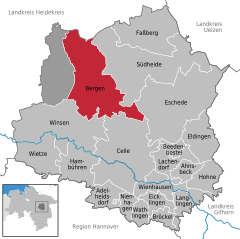
Heidekreis is a district (Landkreis) in Lower Saxony, Germany. It is bounded by the districts of Harburg, Lüneburg, Uelzen, Celle, Hanover, Nienburg, Verden and Rotenburg.
Celle is a district (Landkreis) in Lower Saxony, Germany. It is bounded by the districts of Uelzen, Gifhorn, Hanover and Heidekreis.
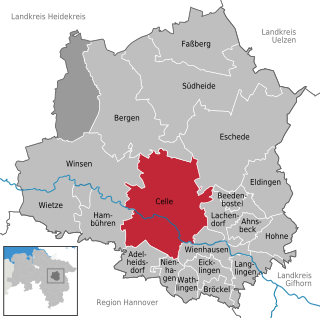
Celle is a town and capital of the district of Celle, in Lower Saxony, Germany. The town is situated on the banks of the river Aller, a tributary of the Weser and has a population of about 71,000. Celle is the southern gateway to the Lüneburg Heath, has a castle built in the Renaissance and Baroque style and a picturesque old town centre with over 400 timber-framed houses, making Celle one of the most remarkable members of the German Timber-Frame Road. From 1378 to 1705, Celle was the official residence of the Lüneburg branch of the dukes of Brunswick-Lüneburg who had been banished from their original ducal seat by its townsfolk.
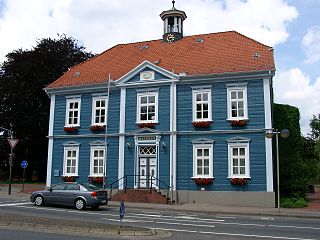
Soltau is a mid-sized town in the Lüneburg Heath in the district of Heidekreis, in Lower Saxony, Germany. It has around 22,000 inhabitants. The city is centrally located in the Lüneburg Heath and is known nationwide especially for its tourist attractions like the Heide-Park and the Soltau-Therme.

Bad Fallingbostel is the district town (Kreisstadt) of the Heidekreis district in the German state of Lower Saxony. Since 1976 the town has had a state-recognised Kneipp spa and has held the title of Bad since 2002. It has close ties to Walsrode, a few miles to the west. Until 2015, there was a British Army base in Bad Fallingbostel, It also hosted Defender 2020 the largest US Army/Nato exercise since the Cold war. The town has around 11,000 inhabitants.

The Böhme is a right-bank, northeastern tributary of the Aller in the district of Soltau-Fallingbostel in the north German state of Lower Saxony. The river is 72 kilometres (45 mi) long.

Lohheide is an unincorporated area in the district of Celle, in Lower Saxony, Germany.
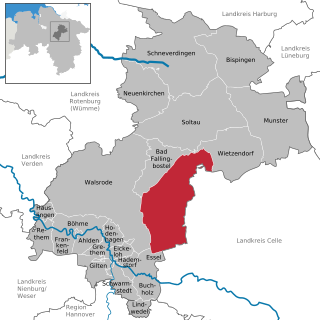
Osterheide is an unincorporated area in the district of Heidekreis, in Lower Saxony, Germany.

Bergen-Hohne Training Area is a NATO military training area in the southern part of the Lüneburg Heath, in the state of Lower Saxony in northern Germany. It covers an area of 284 square kilometres, which makes it the largest military training area in Germany.
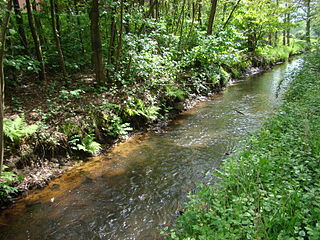
Meiße is a river of Lower Saxony, Germany that flows through part of the Lüneburg Heath. It is a right-hand tributary of the Aller.
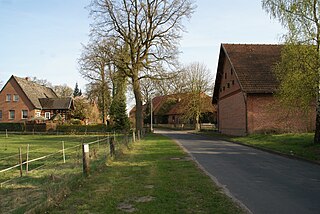
Belsen is a village within the German borough of Bergen in the northern part of Celle district on the Lüneburg Heath in Lower Saxony. The village, whose original site lies about 3 kilometres (1.9 mi) southwest of Bergen, has 331 inhabitants (as at: 31 December 2000). The Belsen concentration camp was named after it. Today Belsen is dominated by the former British Army camp of Hohne on the edge of the NATO firing ranges.
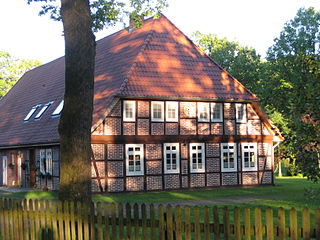
Becklingen is a German village in the Lower Saxon borough of Bergen in the northern part of Celle district on the Lüneburg Heath. Formerly an independent municipality, it is part of the town Bergen since 1971.

The Falkenberg lies in the northwestern part of the district of Celle in northern Germany. It is one of the highest points on the Lüneburg Heath. In good weather Hanover is visible from its summit. It is on the terrain of the NATO facility, the Bergen-Hohne Training Area, in the vicinity of the village of Becklingen.

Diesten is a village subordinated to the Lower Saxon town of Bergen in the northern part of Celle district on the Lüneburg Heath in northern Germany. It lies 20 km north of Celle on Kreisstraße K 240 and has 264 inhabitants.

Sülze is a village in the local borough of Bergen located in the northern part of Celle district on the Lüneburg Heath in North Germany. The infamous Bergen-Belsen concentration camp was located not far from Sülze, one of several farming villages in the borough. The general Bergen area today is economically heavily dependent on the surrounding military bases and the Bergen-Hohne Training Area to the west, which is the largest military training area in Western Europe.

Eversen is a village in the town of Bergen in the northern part of Celle district on the Lüneburg Heath in the north German state of Lower Saxony.

The Großes Moor near Becklingen is a nature reserve in Germany with an area of 850 hectares, of which 666 hectares lie in Celle district and 184 hectares in Soltau-Fallingbostel district. Since 16 December 1985 the area has been protected under conservation law. An area of 776.6 hectares is designated as a special area of conservation (FFH-Gebiet). The name literally means "Large Bog near Becklingen" and it lies on the Lüneburg Heath, south of Wietzendorf and east of Becklingen, part of the borough of Bergen. The River Meiße has its source in this raised bog.

The Church of St. Fabian and St. Sebastian in Sülze, Lower Saxony, Germany is a church of the Evangelical-Lutheran parish in the church district (Kirchenkreis) of Celle and in the Evangelical-Lutheran State Church of Hanover.

Beckedorf is a village and Ortschaft in the municipality of Südheide in northern Celle district in the German state of Lower Saxony. Situated on the western edge of the Southern Heath Nature Park in the Lüneburg Heath, about 1 km southwest of Hermannsburg itself, it currently has about 610 inhabitants. The name means "village on the Beke". In old records it can be found as Beketorpe, Bekendorpe or Beckedorp. In 1973 Beckedorf was incorporated into the parish of Hermannsburg as part of Lower Saxony's territorial and administrative reforms.

Gloucester School was a British military secondary school in Hohne, Germany. It was one of four secondary schools operated by the Service Children's Education in support of British Forces Germany in the post-Cold War period. It served children of military personnel and civilian employees of Bergen-Hohne Garrison with its stations at Fallingbostel, Celle and Hohne. It was a day school only, with no boarding facilities.

